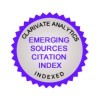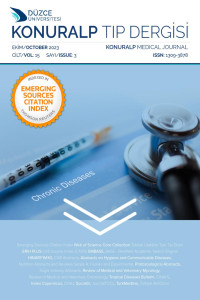Abstract
Amaç: Üçüncü basamak akademik bir hastanenin acil servis başvuruları içerisindeki nöroşirürji konsultasyonlarının incelenerek nöroşirürji ihtiyacı olan hastaların özelliklerinin ortaya konulması amaçlandı.
Metod: Bu retrospektif, tek merkezli gözlemsel bir çalışmadır. 01.01.2022 – 31.12.2022 tarihleri arasında acil servise başvuran ve acil servisten beyin cerrahi bölümüne konsulte edilen hastalar hastane bilgi işlem sistemi üzerinden tespit edilip çalışmaya dahil edildi. Hastaların demografik bilgileri, hastaneye başvuru şekilleri, başvuru nedenleri, başvuru saatleri, çekilen beyin bilgisayarlı tomografi (BT) sayıları, ameliyat olup olmadıkları ve mortalite sonuçları kaydedildi.
Bulgular: Acil servisten bir senede toplamda 441 nöroşirürji konsültasyonu yapıldı. Düşme %35,6 (n=157) ve trafik kazası %16,6 (n=73) en sık konsültasyon sebepleriydi. Hastaların %92,5 (n=408) ‘ine beyin BT çekildiği, %19,5 (n=86) hastaya ise 2 ya da daha çok beyin BT tetkiki yapıldığı görüldü. Nöroşirürjiye konsulte edilen hastaların %12,7 (n=56) ‘sının ameliyat edildiği, %4,1 (n=18) ‘inin hastane başvurusunun eksitus ile sonuçlandığı saptandı. Nöroşirürji konsültasyonu yapılan hastaların sadece %53,7 (n=237) ’si acil servisten taburcu oldu. Mesai saatleri içerisinde anlamlı olarak daha fazla Nöroşirürji konsültasyonu yapıldığı tespit edildi (p=0.013).
Sonuç: Acil servisten nöroşirürjiye yapılan konsültasyon çağrılarının büyük çoğunluğu travma hastaları içindir. Nöroşirürjik hasta değerlendirmesinde sıklıkla beyin BT tetkikinden yararlanılmaktadır. Yapılan konsültasyonlar sonucunda hastaların neredeyse yarısı hastaneye yatırılmaktadır. Acil servis hekimleri nöroşirürji ihtiyacı olan hastaların ayrımını iyi yapabilmektedir.
Keywords
References
- Pearce S, Marchand T, Shannon T, Ganshorn H, Lang E. Emergency department crowding: an overview of reviews describing measures causes, and harms. Intern Emerg Med. 2023;18(4):1137-58.
- 2- Ada D , Ünal B. The Effect of The Primary Care Services on The Intensity of Emergency Care Admissions to Public Hospitals in Turkey: An Ecological Study. JBACHS. 2018; 2(3): 82-7.
- 3- Guertler AT, Cortazzo JM, Rice MM. Referral and consultation in emergency medicine practice. Acad Emerg Med. 1994;1(6):565-571.
- 4- Voaklander B, Gaudet LA, Kirkland SW, et al. Interventions to improve consultations in the emergency department: A systematic review. Acad Emerg Med. 2022;29(12):1475-95.
- 5- Lee RS, Woods R, Bullard M, Holroyd BR, Rowe BH. Consultations in the emergency department: a systematic review of the literature. Emerg Med J. 2008;25(1):4-9.
- 6- Brick C, Lowes J, Lovstrom L, Kokotilo A, Villa-Roel C, Lee P, et al. The impact of consultation on length of stay in tertiary care emergency departments. Emerg Med J. 2014;31(2):134-8.
- 7- Anstey J, Lucas BP. Worry Loves Company, but Unnecessary Consultations May Harm the Patients We Comanage. J Hosp Med. 2020;15(1):60-1.
- 8- Park KB, Johnson WD, Dempsey RJ. Global Neurosurgery: The Unmet Need. World Neurosurg. 2016;88:32-5.
- 9- Jayakumar N, Kennion O, Villabona AR, Paranathala M, Holliman D. Neurosurgical Referral Patterns During the Coronavirus Disease 2019 Pandemic: A United Kingdom Experience. World Neurosurg. 2020;144:414-20.
- 10- Kelly DF, Becker DP. Advances in management of neurosurgical trauma: USA and Canada. World J Surg. 2001;25(9):1179-85.
- 11- Mollayeva T, Mollayeva S, Colantonio A. Traumatic brain injury: sex, gender and intersecting vulnerabilities. Nat Rev Neurol. 2018;14(12):711-22.
- 12- Thurman DJ. The Epidemiology of Traumatic Brain Injury in Children and Youths: A Review of Research Since 1990. J Child Neurol. 2016;31(1):20-7.
- 13- Qirjako G, Burazeri G, Hysa B, Roshi E. Factors associated with fatal traffic accidents in Tirana, Albania: cross-sectional study. Croat Med J. 2008;49(6):734-40.
- 14- Patton GG, Thakore S. Reducing inappropriate emergency department attendances--a review of ambulance service attendances at a regional teaching hospital in Scotland. Emerg Med J. 2013;30(6):459-61
- 15- Markham D, Graudins A. Characteristics of frequent emergency department presenters to an Australian emergency medicine network. BMC Emerg Med. 2011;11:21.
- 16- Sprivulis P, Grainger S, Nagree Y. Ambulance diversion is not associated with low acuity patients attending Perth metropolitan emergency departments. Emerg Med Australas. 2005;17(1):11-5.
- 17- Ruger JP, Richter CJ, Lewis LM. Clinical and economic factors associated with ambulance use to the emergency department. Acad Emerg Med. 2006;13(8):879-85.
- 18- Kılıçarslan İ, Bozan H, Oktay C, Göksu E. Demographic properties of patients presenting to the emergency department in Turkey. Türkiye Acil Tıp Dergisi 2005; 5(1): 5-13
- 19- Demir MC, Akkas M. Awareness of Risks Associated with the Use of Plain X-Ray, Computed Tomography, and Magnetic Resonance Imaging Among Emergency Physicians and Comparison with that of Other Physicians: A Survey from Turkey. Med Sci Monit. 2019;25:6587-6597
- 20- Novoa Ferro M, Santos Armentia E, Silva Priegue N, et al. Brain CT requests from emergency department: Reality. Radiologia (Engl Ed). 2022;64(5):422-32.
- 21- Sert ET, Mutlu H, Yeşildağ K, et al. 5-Year Analysis of Patients Admitted to Our Emergency Department. Medical Journal of Mugla Sitki Kocman University 2021;8(1):1-4
Abstract
Objective: To reveal the characteristics of patients needing neurosurgery by examining neurosurgery consultations within the emergency department (ED) admissions of a tertiary academic hospital.
Method: This is a retrospective, single-centre observational study. Patients admitted to the ED between 01.01.2022 and 31.12.2022 and consulted to the neurosurgery department were identified through the hospital computer system and included in the study. The demographic information of the patients, mode of admission to the ED, the reasons for admission, the time of admission, the number of brain computed tomography (CT) scans, whether they underwent surgery or not, and the mortality results were recorded.
Results: A total of 441 neurosurgery consultations were examined. Fall 35.6% (n=157) and traffic accident 16.6% (n=73) were the most common reasons for consultation. It was observed that 92.5% (n=408) of the patients had a brain CT scan, and 19.5% (n=86) had two or more brain CTs. It was determined that 12.7% (n=56) of the patients consulted for neurosurgery were operated on, and 4.1% (n=18) of the patients' hospital admissions resulted in death. Only 53.7% (n=237) of the patients who underwent neurosurgery consultation were discharged from the ED. It was determined that significantly more Neurosurgery consultations were requested during working hours (p = 0.013)
Conclusion: Most consultation calls from the ED to neurosurgery are for trauma patients. Brain CT examination is frequently used in neurosurgical patient evaluation. As a result of the consultations, almost half of the patients are hospitalized. Emergency physicians can select patients who need neurosurgery well.
Keywords
References
- Pearce S, Marchand T, Shannon T, Ganshorn H, Lang E. Emergency department crowding: an overview of reviews describing measures causes, and harms. Intern Emerg Med. 2023;18(4):1137-58.
- 2- Ada D , Ünal B. The Effect of The Primary Care Services on The Intensity of Emergency Care Admissions to Public Hospitals in Turkey: An Ecological Study. JBACHS. 2018; 2(3): 82-7.
- 3- Guertler AT, Cortazzo JM, Rice MM. Referral and consultation in emergency medicine practice. Acad Emerg Med. 1994;1(6):565-571.
- 4- Voaklander B, Gaudet LA, Kirkland SW, et al. Interventions to improve consultations in the emergency department: A systematic review. Acad Emerg Med. 2022;29(12):1475-95.
- 5- Lee RS, Woods R, Bullard M, Holroyd BR, Rowe BH. Consultations in the emergency department: a systematic review of the literature. Emerg Med J. 2008;25(1):4-9.
- 6- Brick C, Lowes J, Lovstrom L, Kokotilo A, Villa-Roel C, Lee P, et al. The impact of consultation on length of stay in tertiary care emergency departments. Emerg Med J. 2014;31(2):134-8.
- 7- Anstey J, Lucas BP. Worry Loves Company, but Unnecessary Consultations May Harm the Patients We Comanage. J Hosp Med. 2020;15(1):60-1.
- 8- Park KB, Johnson WD, Dempsey RJ. Global Neurosurgery: The Unmet Need. World Neurosurg. 2016;88:32-5.
- 9- Jayakumar N, Kennion O, Villabona AR, Paranathala M, Holliman D. Neurosurgical Referral Patterns During the Coronavirus Disease 2019 Pandemic: A United Kingdom Experience. World Neurosurg. 2020;144:414-20.
- 10- Kelly DF, Becker DP. Advances in management of neurosurgical trauma: USA and Canada. World J Surg. 2001;25(9):1179-85.
- 11- Mollayeva T, Mollayeva S, Colantonio A. Traumatic brain injury: sex, gender and intersecting vulnerabilities. Nat Rev Neurol. 2018;14(12):711-22.
- 12- Thurman DJ. The Epidemiology of Traumatic Brain Injury in Children and Youths: A Review of Research Since 1990. J Child Neurol. 2016;31(1):20-7.
- 13- Qirjako G, Burazeri G, Hysa B, Roshi E. Factors associated with fatal traffic accidents in Tirana, Albania: cross-sectional study. Croat Med J. 2008;49(6):734-40.
- 14- Patton GG, Thakore S. Reducing inappropriate emergency department attendances--a review of ambulance service attendances at a regional teaching hospital in Scotland. Emerg Med J. 2013;30(6):459-61
- 15- Markham D, Graudins A. Characteristics of frequent emergency department presenters to an Australian emergency medicine network. BMC Emerg Med. 2011;11:21.
- 16- Sprivulis P, Grainger S, Nagree Y. Ambulance diversion is not associated with low acuity patients attending Perth metropolitan emergency departments. Emerg Med Australas. 2005;17(1):11-5.
- 17- Ruger JP, Richter CJ, Lewis LM. Clinical and economic factors associated with ambulance use to the emergency department. Acad Emerg Med. 2006;13(8):879-85.
- 18- Kılıçarslan İ, Bozan H, Oktay C, Göksu E. Demographic properties of patients presenting to the emergency department in Turkey. Türkiye Acil Tıp Dergisi 2005; 5(1): 5-13
- 19- Demir MC, Akkas M. Awareness of Risks Associated with the Use of Plain X-Ray, Computed Tomography, and Magnetic Resonance Imaging Among Emergency Physicians and Comparison with that of Other Physicians: A Survey from Turkey. Med Sci Monit. 2019;25:6587-6597
- 20- Novoa Ferro M, Santos Armentia E, Silva Priegue N, et al. Brain CT requests from emergency department: Reality. Radiologia (Engl Ed). 2022;64(5):422-32.
- 21- Sert ET, Mutlu H, Yeşildağ K, et al. 5-Year Analysis of Patients Admitted to Our Emergency Department. Medical Journal of Mugla Sitki Kocman University 2021;8(1):1-4
Details
| Primary Language | English |
|---|---|
| Subjects | Health Services and Systems (Other) |
| Journal Section | Articles |
| Authors | |
| Publication Date | October 20, 2023 |
| Acceptance Date | October 16, 2023 |
| Published in Issue | Year 2023 Volume: 15 Issue: 3 |
Cite
Cited By
Bedridden Patients at Emergency Department: Can We Treat Them at Home?
Online Türk Sağlık Bilimleri Dergisi
https://doi.org/10.26453/otjhs.1610351




